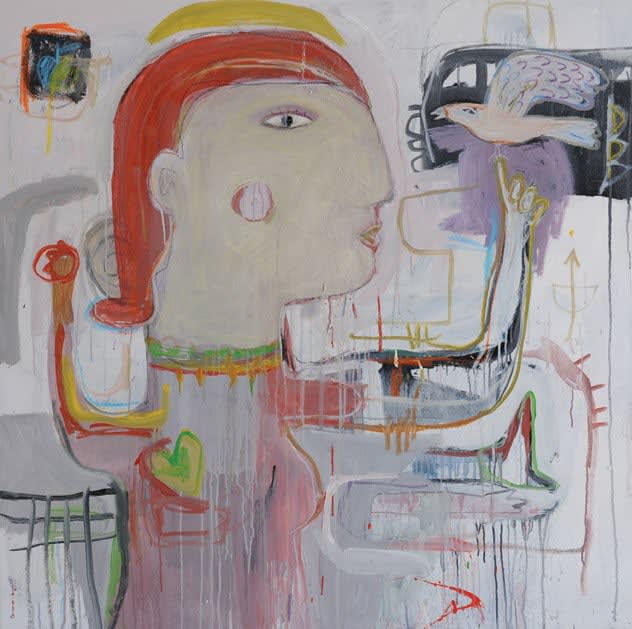Ayyam Gallery, Dubai is pleased to announce the solo exhibition of Palestinian painter Oussama Diab, which will be held from January 25 to February 27. Ayyam’s partnership with Diab demonstrates its continued support of emerging talent and commitment to presenting some of the latest trends in Middle Eastern art. With successful sales in the recent Young Collectors Auction and an exciting new body of work that was well- received in a solo show at Ayyam Gallery, Damascus, Diab has been making waves in the regional scene.
Born in Syria to Palestinian parents in 1977, he graduated from the Faculty of Fines Arts in Damascus in 2002. His recent series of paintings reflects a profound investigation into global political concerns while hinting at the artist’s passion for international art. Inspired in part by American painter Jean-Michel Basquiat, Diab’s work presents an exciting new take on graffiti-inspired Neo-Expressionism. At once pop-infused and whimsical, these canvases are also frequently discernible by their grave subject matter, a juxtaposition that reflects the dynamic duality of his art.
Empty space, painted in broad off-white brushwork surrounds the artist’s figures. At times his strokes encircle their forms, creating a sense of energy and movement with paint. His markings appear quick and spontaneous with an overwhelming urgency, while his subjects exist in a nondescript setting, a technique that creates a sense of universality. Working in a heavily symbolic mode—in which every object and figure suggests a specific meaning—each composition possesses a story of its own, as the artist meticulously recounts tales of love, hate, politics and society. For Diab, “There is a proverb saying, ‘we are entitled to hope,’ there is always a problem, or an obstacle, but there is always hope, a solution to finding the light.”
His vivid palette suggests this positive outlook. Reds, blues, yellows, purples and greens dominate his compositions, hues that suggest the vitality of life. A pantheon of art world greats makes its way into his compositions. Basquiat-like heads, Picasso-esque mermaids and centaurs, Munch’s scream and da Vinci’s Mona Lisa are all situated within the artist’s narrative. A deliberate commentary on the state of the world, the use of these recognizable images works to draw the viewer into a realm where contradictions reign supreme. Flowers appear as peace offerings, at times horses stand in for human subjects and gas masks suggest a pending nuclear crisis or the masks behind which world leaders often hide.
In one work a winged horse stands with its back to a soldier who offers a bouquet. Rearing its head with contempt, the horse seems suspicious of this gesture. Below one of its hoofs lies a trap while an unidentified arm attempts to strangle the animal. With the soldier poised with smile and his hand extended with a gift, at first glance the painting suggests an amicable exchange. Yet as is evident in all of his canvases, Diab has placed deeper meaning in his symbols. Using the horse as a representation of mankind and the soldier as the face of political policy, the artist presents a complex understanding of the state of world affairs, one in which empty promises of peace and prosperity appear abundant. His employment of the horse is also reminiscent of the rich tradition of symbolism that is found in Palestinian visual culture. With pioneering modernists such as Tamam al-Akhal, Abdul Rahman al Muzayan and the late Mustapha Hallaj using it as a political iconification of the Palestinian people, this anthropomorphic image has a long history. Here Diab has restored its image and asks for social change.
Most recently, the issue of nuclear weapons has impacted the artist’s work. “Soon we will all be equal,” he affirms. “We will have the same harm, the same fear and the same instability, even the Mona Lisa will be affected. Even the Scream, these are a call for help.” In a painting titled The New Mona Lisa (2009), Diab emphasizes this point. Wearing a gas mask, da Vinci’s infamous heroine peeks out at the viewer. Nearby is a sign that clearly states “no missiles” and an airplane that appears headed her way. Campy, and bold, there is also a degree of seriousness to the painting, as the artist confirms that it suggests “In the end this is what will transpire, what will capture the whole world. Even the art world won’t be able to escape it.” For Diab, these matters affect us all.

